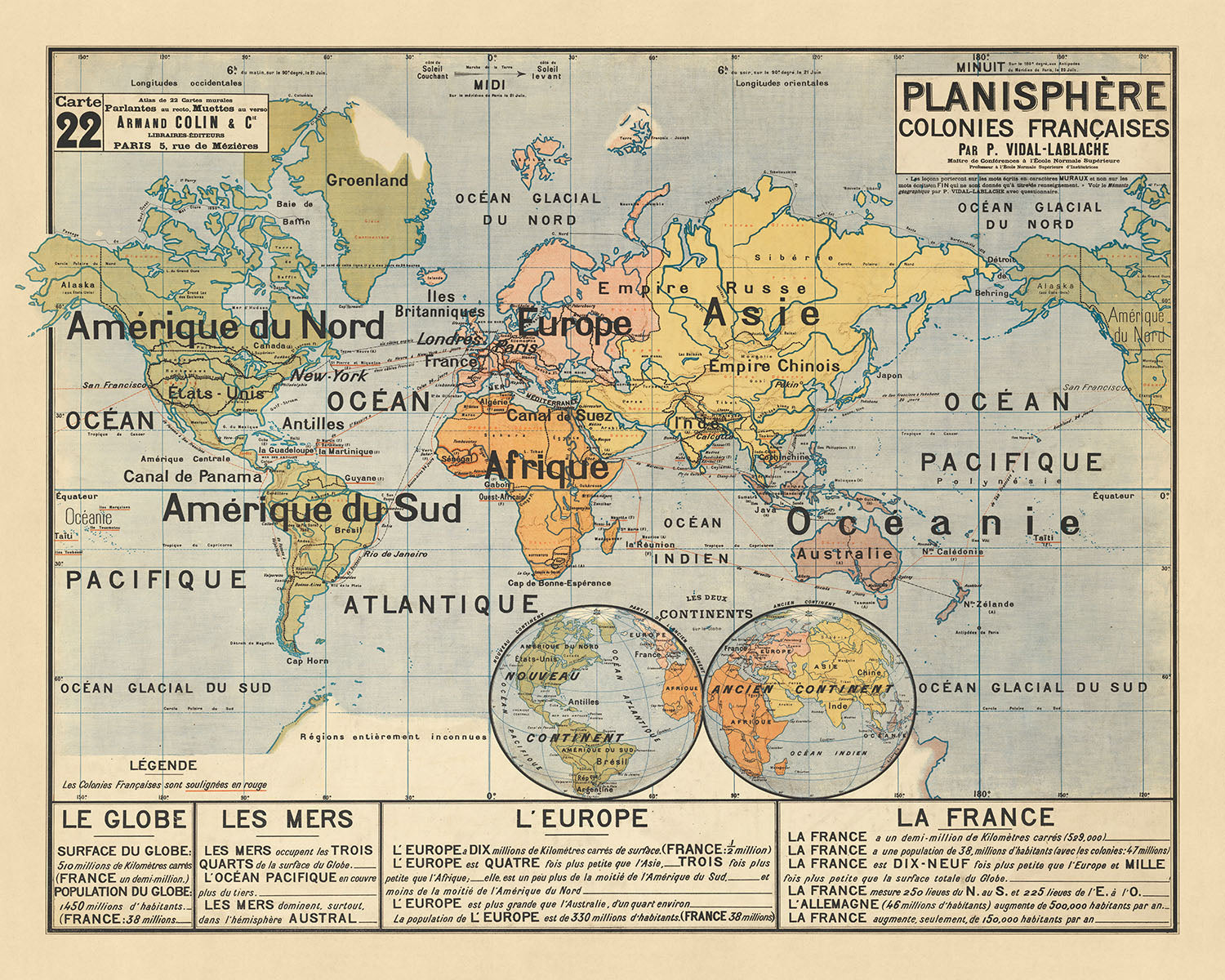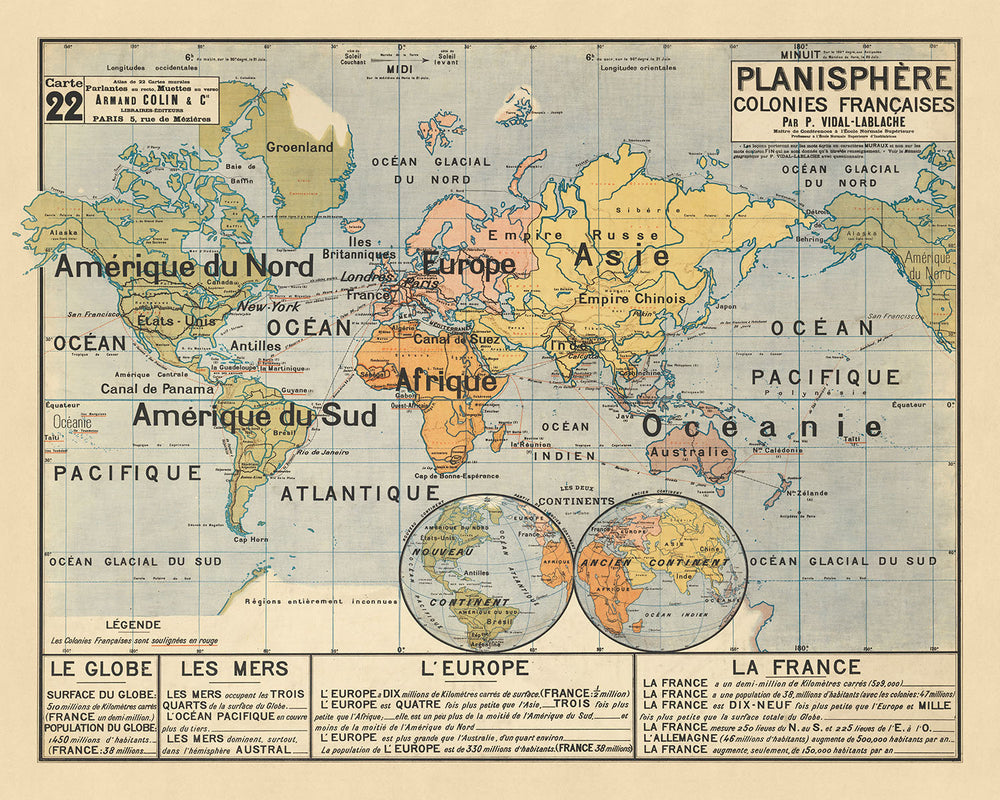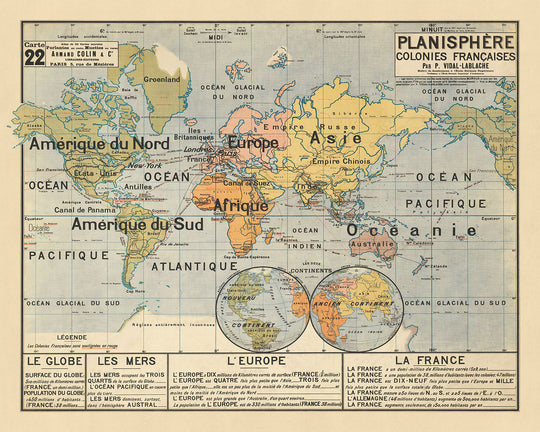- Handmade locally. No import duty or tax
- FREE worldwide delivery
- Love it or your money back (90 days)
- Questions? WhatsApp me any time
Own a piece of history
5,000+ 5 star reviews


Embark on a journey through time and space with the exquisite "Planisphere" by Paul Vidal de La Blache and published by Armand Colin Editeur, a masterpiece crafted in the heart of Paris at 5, rue de Mezieres. This thematic map, a testament to the golden age of exploration and cartography, captures the world in a way that is both educational and awe-inspiring. Designed with the purpose of enlightening minds, the Planisphere serves as a window to the vast expanses of our planet, showcasing the intricate web of sea, road, and rail routes that connect distant lands. From the historic Suez and Panama Canals to the legendary route from Marseille to Yokohama, this map invites viewers to trace the paths that have shaped human history.
The Planisphere is not just a map; it is a vibrant tableau that brings to life the physical and political landscapes of the late 19th to early 20th century. The map's thematic design highlights the world's major bodies of water, from the icy realms of the Arctic and Southern Oceans to the tranquil waters of the Mediterranean Sea. Mountain ranges such as the Alps, Andes, Himalayas, and Rocky Mountains rise majestically, their peaks a testament to the earth's age-old narratives. This cartographic gem goes beyond mere geography, offering a glimpse into the geopolitical dynamics of the era, with French colonies vividly underlined in red, marking their significance on the global stage.
The stylistic choices made by Armand Colin Editeur in the creation of the Planisphere are nothing short of revolutionary. Utilizing a thematic map style, the cartographers have managed to distill complex information into an accessible and visually striking format. The exaggerated sizes of cities and continents, labeled with massive letters, ensure that the map remains an invaluable educational tool, capable of engaging viewers from across a room. This design choice not only emphasizes the importance of key locations but also reflects the educational priorities of the time, making knowledge accessible to all.
In addition to its educational value, the Planisphere is a marvel of cartographic design. The map employs a projection that balances the need for accuracy with the aesthetic demands of a wall map intended for display. Each continent, ocean, and geographical feature is rendered with meticulous attention to detail, allowing for a comprehensive understanding of the world's geography. The inclusion of insets such as "Surface du Globe" and "Les Mers" further enriches the viewer's experience, offering detailed insights into specific aspects of the earth's surface and its vast bodies of water.
The Planisphere by Armand Colin Editeur is more than a map; it is a historical document that captures the essence of an era when the world was still being explored and understood. It reflects the ambitions and curiosities of its time, serving as a testament to the human desire to know and connect with the world. For collectors, historians, and anyone with an appreciation for the art of cartography, this map is a treasure, offering endless opportunities for discovery and wonder. As we gaze upon the Planisphere, we are reminded of the journeys that have led us here and the endless possibilities that our world holds.
Countries and regions on this map
- Europe
- Asie (Asia)
- Afrique (Africa)
- Amerique du Nord (North America)
- Amerique du Sud (South America)
- Oceanie (Oceania)
- Groenland (Greenland)
- Islande (Iceland)
- Spitzberg
- Russie (Russia)
- Empire Chinois (Chinese Empire)
- Japon (Japan)
- Indes (India)
- Ocean Glacial Arctique (Arctic Ocean)
- Ocean Atlantique (Atlantic Ocean)
- Ocean Pacifique (Pacific Ocean)
- Ocean Glacial du Sud (Southern Ocean)
- Canal de Panama (Panama Canal)
- Canal de Suez (Suez Canal)
- New York
- Londres (London)
- Berlin
- Rome
- Vienne (Vienna)
- Constantinople (Istanbul)
- Le Caire (Cairo)
- Bombay
- Calcutta
- Pekin (Beijing)
- Tokio (Tokyo)
- Sydney
- Melbourne
- San Francisco
- Chicago
- Montreal
- Buenos-Ayres (Buenos Aires)
- Rio de Janeiro
Notable Features & Landmarks
- Insets:
- Surface du Globe
- Les Mers
- L'Europe
- La France
- Bodies of water:
- Atlantic Ocean
- Arctic Ocean
- Indian Ocean
- Mediterranean Sea
- North Sea
- Pacific Ocean
- Red Sea
- Southern Ocean
- Mountain ranges:
- Alps
- Andes
- Himalayas
- Rocky Mountains
- Sea, road and rail routes:
- Route from Marseille to Yokohama
- Suez Canal
- Panama Canal
- Other:
- Equator
- Prime Meridian
- Tropic of Cancer
- Tropic of Capricorn
- Arctic Circle
- Antarctic Circle
Historical and design context
- An educational wall map (school map) of the world, with exaggerated cities and continents.
- Cities and continents are labelled with massive letters as befits an educational map that can be read from the back of the room.
- French colonies in the New World, Africa, and Asia are underlined in red.
Please double check the images to make sure that a specific town or place is shown on this map. You can also get in touch and ask us to check the map for you.
This map looks great at every size, but I always recommend going for a larger size if you have space. That way you can easily make out all of the details.
This map looks amazing at sizes all the way up to 100in (250cm). If you are looking for a larger map, please get in touch.
The model in the listing images is holding the 16x20in (40x50cm) version of this map.
The fifth listing image shows an example of my map personalisation service.
If you’re looking for something slightly different, check out my collection of the best old maps to see if something else catches your eye.
Please contact me to check if a certain location, landmark or feature is shown on this map.
This would make a wonderful birthday, Christmas, Father's Day, work leaving, anniversary or housewarming gift for someone from the areas covered by this map.
This map is available as a giclée print on acid free archival matte paper, or you can buy it framed. The frame is a nice, simple black frame that suits most aesthetics. Please get in touch if you'd like a different frame colour or material. My frames are glazed with super-clear museum-grade acrylic (perspex/acrylite), which is significantly less reflective than glass, safer, and will always arrive in perfect condition.
This map is also available as a float framed canvas, sometimes known as a shadow gap framed canvas or canvas floater. The map is printed on artist's cotton canvas and then stretched over a handmade box frame. We then "float" the canvas inside a wooden frame, which is available in a range of colours (black, dark brown, oak, antique gold and white). This is a wonderful way to present a map without glazing in front. See some examples of float framed canvas maps and explore the differences between my different finishes.
For something truly unique, this map is also available in "Unique 3D", our trademarked process that dramatically transforms the map so that it has a wonderful sense of depth. We combine the original map with detailed topography and elevation data, so that mountains and the terrain really "pop". For more info and examples of 3D maps, check my Unique 3D page.
For most orders, delivery time is about 3 working days. Personalised and customised products take longer, as I have to do the personalisation and send it to you for approval, which usually takes 1 or 2 days.
Please note that very large framed orders usually take longer to make and deliver.
If you need your order to arrive by a certain date, please contact me before you order so that we can find the best way of making sure you get your order in time.
I print and frame maps and artwork in 23 countries around the world. This means your order will be made locally, which cuts down on delivery time and ensures that it won't be damaged during delivery. You'll never pay customs or import duty, and we'll put less CO2 into the air.
All of my maps and art prints are well packaged and sent in a rugged tube if unframed, or surrounded by foam if framed.
I try to send out all orders within 1 or 2 days of receiving your order, though some products (like face masks, mugs and tote bags) can take longer to make.
If you select Express Delivery at checkout your order we will prioritise your order and send it out by 1-day courier (Fedex, DHL, UPS, Parcelforce).
Next Day delivery is also available in some countries (US, UK, Singapore, UAE) but please try to order early in the day so that we can get it sent out on time.
My standard frame is a gallery style black ash hardwood frame. It is simple and quite modern looking. My standard frame is around 20mm (0.8in) wide.
I use super-clear acrylic (perspex/acrylite) for the frame glass. It's lighter and safer than glass - and it looks better, as the reflectivity is lower.
Six standard frame colours are available for free (black, dark brown, dark grey, oak, white and antique gold). Custom framing and mounting/matting is available if you're looking for something else.
Most maps, art and illustrations are also available as a framed canvas. We use matte (not shiny) cotton canvas, stretch it over a sustainably sourced box wood frame, and then 'float' the piece within a wood frame. The end result is quite beautiful, and there's no glazing to get in the way.
All frames are provided "ready to hang", with either a string or brackets on the back. Very large frames will have heavy duty hanging plates and/or a mounting baton. If you have any questions, please get in touch.
See some examples of my framed maps and framed canvas maps.
Alternatively, I can also supply old maps and artwork on canvas, foam board, cotton rag and other materials.
If you want to frame your map or artwork yourself, please read my size guide first.
My maps are extremely high quality reproductions of original maps.
I source original, rare maps from libraries, auction houses and private collections around the world, restore them at my London workshop, and then use specialist giclée inks and printers to create beautiful maps that look even better than the original.
My maps are printed on acid-free archival matte (not glossy) paper that feels very high quality and almost like card. In technical terms the paper weight/thickness is 10mil/200gsm. It's perfect for framing.
I print with Epson ultrachrome giclée UV fade resistant pigment inks - some of the best inks you can find.
I can also make maps on canvas, cotton rag and other exotic materials.
Learn more about The Unique Maps Co.
Map personalisation
If you're looking for the perfect anniversary or housewarming gift, I can personalise your map to make it truly unique. For example, I can add a short message, or highlight an important location, or add your family's coat of arms.
The options are almost infinite. Please see my map personalisation page for some wonderful examples of what's possible.
To order a personalised map, select "personalise your map" before adding it to your basket.
Get in touch if you're looking for more complex customisations and personalisations.
Map ageing
I have been asked hundreds of times over the years by customers if they could buy a map that looks even older.
Well, now you can, by selecting Aged before you add a map to your basket.
All the product photos you see on this page show the map in its Original form. This is what the map looks like today.
If you select Aged, I will age your map by hand, using a special and unique process developed through years of studying old maps, talking to researchers to understand the chemistry of aging paper, and of course... lots of practice!
If you're unsure, stick to the Original colour of the map. If you want something a bit darker and older looking, go for Aged.
If you are not happy with your order for any reason, contact me and I'll get it fixed ASAP, free of charge. Please see my returns and refund policy for more information.
I am very confident you will like your restored map or art print. I have been doing this since 1984. I'm a 5-star Etsy seller. I have sold tens of thousands of maps and art prints and have over 5,000 real 5-star reviews. My work has been featured in interior design magazines, on the BBC, and on the walls of dozens of 5-star hotels.
I use a unique process to restore maps and artwork that is massively time consuming and labour intensive. Hunting down the original maps and illustrations can take months. I use state of the art and eye-wateringly expensive technology to scan and restore them. As a result, I guarantee my maps and art prints are a cut above the rest. I stand by my products and will always make sure you're 100% happy with what you receive.
Almost all of my maps and art prints look amazing at large sizes (200cm, 6.5ft+) and I can frame and deliver them to you as well, via special oversized courier. Contact me to discuss your specific needs.
Or try searching for something!















































